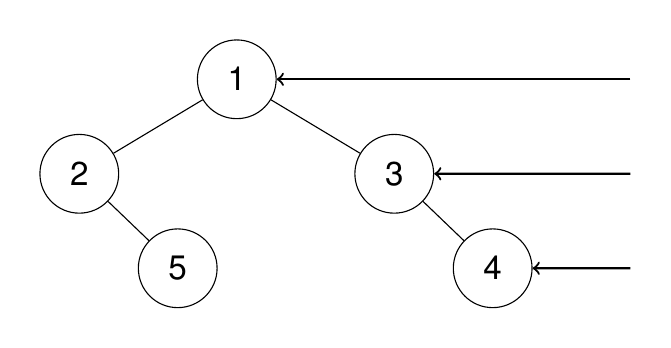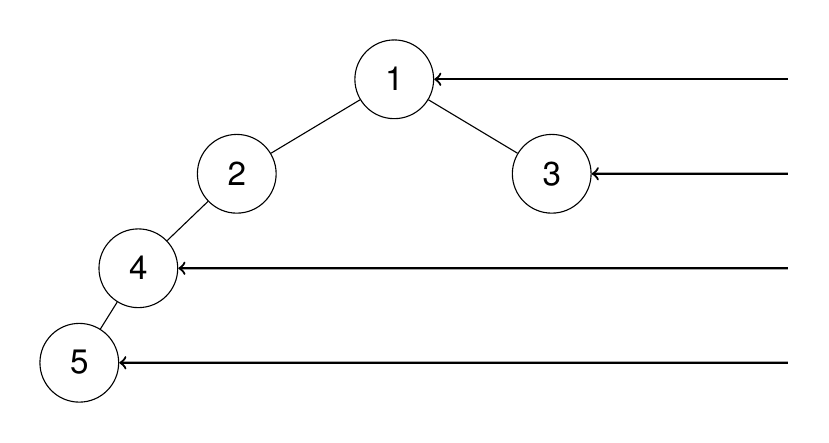| comments | difficulty | edit_url | tags | ||||
|---|---|---|---|---|---|---|---|
true |
中等 |
|
给定一个二叉树的 根节点 root,想象自己站在它的右侧,按照从顶部到底部的顺序,返回从右侧所能看到的节点值。
示例 1:
示例 2:
示例 3:
输入:root = [1,null,3]
输出:[1,3]
示例 4:
输入:root = []
输出:[]
提示:
- 二叉树的节点个数的范围是
[0,100] -100 <= Node.val <= 100
我们可以使用广度优先搜索,定义一个队列
时间复杂度
# Definition for a binary tree node.
# class TreeNode:
# def __init__(self, val=0, left=None, right=None):
# self.val = val
# self.left = left
# self.right = right
class Solution:
def rightSideView(self, root: Optional[TreeNode]) -> List[int]:
ans = []
if root is None:
return ans
q = deque([root])
while q:
ans.append(q[0].val)
for _ in range(len(q)):
node = q.popleft()
if node.right:
q.append(node.right)
if node.left:
q.append(node.left)
return ans/**
* Definition for a binary tree node.
* public class TreeNode {
* int val;
* TreeNode left;
* TreeNode right;
* TreeNode() {}
* TreeNode(int val) { this.val = val; }
* TreeNode(int val, TreeNode left, TreeNode right) {
* this.val = val;
* this.left = left;
* this.right = right;
* }
* }
*/
class Solution {
public List<Integer> rightSideView(TreeNode root) {
List<Integer> ans = new ArrayList<>();
if (root == null) {
return ans;
}
Deque<TreeNode> q = new ArrayDeque<>();
q.offer(root);
while (!q.isEmpty()) {
ans.add(q.peekFirst().val);
for (int k = q.size(); k > 0; --k) {
TreeNode node = q.poll();
if (node.right != null) {
q.offer(node.right);
}
if (node.left != null) {
q.offer(node.left);
}
}
}
return ans;
}
}/**
* Definition for a binary tree node.
* struct TreeNode {
* int val;
* TreeNode *left;
* TreeNode *right;
* TreeNode() : val(0), left(nullptr), right(nullptr) {}
* TreeNode(int x) : val(x), left(nullptr), right(nullptr) {}
* TreeNode(int x, TreeNode *left, TreeNode *right) : val(x), left(left), right(right) {}
* };
*/
class Solution {
public:
vector<int> rightSideView(TreeNode* root) {
vector<int> ans;
if (!root) {
return ans;
}
queue<TreeNode*> q{{root}};
while (q.size()) {
ans.push_back(q.front()->val);
for (int k = q.size(); k; --k) {
auto node = q.front();
q.pop();
if (node->right) {
q.push(node->right);
}
if (node->left) {
q.push(node->left);
}
}
}
return ans;
}
};/**
* Definition for a binary tree node.
* type TreeNode struct {
* Val int
* Left *TreeNode
* Right *TreeNode
* }
*/
func rightSideView(root *TreeNode) (ans []int) {
if root == nil {
return
}
q := []*TreeNode{root}
for len(q) > 0 {
ans = append(ans, q[0].Val)
for k := len(q); k > 0; k-- {
node := q[0]
q = q[1:]
if node.Right != nil {
q = append(q, node.Right)
}
if node.Left != nil {
q = append(q, node.Left)
}
}
}
return
}/**
* Definition for a binary tree node.
* class TreeNode {
* val: number
* left: TreeNode | null
* right: TreeNode | null
* constructor(val?: number, left?: TreeNode | null, right?: TreeNode | null) {
* this.val = (val===undefined ? 0 : val)
* this.left = (left===undefined ? null : left)
* this.right = (right===undefined ? null : right)
* }
* }
*/
function rightSideView(root: TreeNode | null): number[] {
const ans: number[] = [];
if (!root) {
return ans;
}
const q: TreeNode[] = [root];
while (q.length > 0) {
ans.push(q[0].val);
const nq: TreeNode[] = [];
for (const { left, right } of q) {
if (right) {
nq.push(right);
}
if (left) {
nq.push(left);
}
}
q.length = 0;
q.push(...nq);
}
return ans;
}// Definition for a binary tree node.
// #[derive(Debug, PartialEq, Eq)]
// pub struct TreeNode {
// pub val: i32,
// pub left: Option<Rc<RefCell<TreeNode>>>,
// pub right: Option<Rc<RefCell<TreeNode>>>,
// }
//
// impl TreeNode {
// #[inline]
// pub fn new(val: i32) -> Self {
// TreeNode {
// val,
// left: None,
// right: None
// }
// }
// }
use std::cell::RefCell;
use std::collections::VecDeque;
use std::rc::Rc;
impl Solution {
pub fn right_side_view(root: Option<Rc<RefCell<TreeNode>>>) -> Vec<i32> {
let mut ans = vec![];
if root.is_none() {
return ans;
}
let mut q = VecDeque::new();
q.push_back(root);
while !q.is_empty() {
let k = q.len();
ans.push(q[0].as_ref().unwrap().borrow().val);
for _ in 0..k {
if let Some(node) = q.pop_front().unwrap() {
let mut node = node.borrow_mut();
if node.right.is_some() {
q.push_back(node.right.take());
}
if node.left.is_some() {
q.push_back(node.left.take());
}
}
}
}
ans
}
}/**
* Definition for a binary tree node.
* function TreeNode(val, left, right) {
* this.val = (val===undefined ? 0 : val)
* this.left = (left===undefined ? null : left)
* this.right = (right===undefined ? null : right)
* }
*/
/**
* @param {TreeNode} root
* @return {number[]}
*/
var rightSideView = function (root) {
const ans = [];
if (!root) {
return ans;
}
const q = [root];
while (q.length > 0) {
ans.push(q[0].val);
const nq = [];
for (const { left, right } of q) {
if (right) {
nq.push(right);
}
if (left) {
nq.push(left);
}
}
q.length = 0;
q.push(...nq);
}
return ans;
};使用 DFS 深度优先遍历二叉树,每次先遍历右子树,再遍历左子树,这样每层第一个遍历到的节点即为该层的右视图节点。
时间复杂度
# Definition for a binary tree node.
# class TreeNode:
# def __init__(self, val=0, left=None, right=None):
# self.val = val
# self.left = left
# self.right = right
class Solution:
def rightSideView(self, root: Optional[TreeNode]) -> List[int]:
def dfs(root: Optional[TreeNode], depth: int) -> None:
if root is None:
return
if len(ans) == depth:
ans.append(root.val)
dfs(root.right, depth + 1)
dfs(root.left, depth + 1)
ans = []
dfs(root, 0)
return ans/**
* Definition for a binary tree node.
* public class TreeNode {
* int val;
* TreeNode left;
* TreeNode right;
* TreeNode() {}
* TreeNode(int val) { this.val = val; }
* TreeNode(int val, TreeNode left, TreeNode right) {
* this.val = val;
* this.left = left;
* this.right = right;
* }
* }
*/
class Solution {
private List<Integer> ans = new ArrayList<>();
public List<Integer> rightSideView(TreeNode root) {
dfs(root, 0);
return ans;
}
private void dfs(TreeNode root, int depth) {
if (root == null) {
return;
}
if (ans.size() == depth) {
ans.add(root.val);
}
dfs(root.right, depth + 1);
dfs(root.left, depth + 1);
}
}/**
* Definition for a binary tree node.
* struct TreeNode {
* int val;
* TreeNode *left;
* TreeNode *right;
* TreeNode() : val(0), left(nullptr), right(nullptr) {}
* TreeNode(int x) : val(x), left(nullptr), right(nullptr) {}
* TreeNode(int x, TreeNode *left, TreeNode *right) : val(x), left(left), right(right) {}
* };
*/
class Solution {
public:
vector<int> rightSideView(TreeNode* root) {
vector<int> ans;
auto dfs = [&](this auto&& dfs, TreeNode* root, int depth) -> void {
if (!root) {
return;
}
if (ans.size() == depth) {
ans.push_back(root->val);
}
dfs(root->right, depth + 1);
dfs(root->left, depth + 1);
};
dfs(root, 0);
return ans;
}
};/**
* Definition for a binary tree node.
* type TreeNode struct {
* Val int
* Left *TreeNode
* Right *TreeNode
* }
*/
func rightSideView(root *TreeNode) (ans []int) {
var dfs func(*TreeNode, int)
dfs = func(root *TreeNode, depth int) {
if root == nil {
return
}
if len(ans) == depth {
ans = append(ans, root.Val)
}
dfs(root.Right, depth+1)
dfs(root.Left, depth+1)
}
dfs(root, 0)
return
}/**
* Definition for a binary tree node.
* class TreeNode {
* val: number
* left: TreeNode | null
* right: TreeNode | null
* constructor(val?: number, left?: TreeNode | null, right?: TreeNode | null) {
* this.val = (val===undefined ? 0 : val)
* this.left = (left===undefined ? null : left)
* this.right = (right===undefined ? null : right)
* }
* }
*/
function rightSideView(root: TreeNode | null): number[] {
const ans = [];
const dfs = (root: TreeNode | null, depth: number) => {
if (!root) {
return;
}
if (ans.length == depth) {
ans.push(root.val);
}
dfs(root.right, depth + 1);
dfs(root.left, depth + 1);
};
dfs(root, 0);
return ans;
}// Definition for a binary tree node.
// #[derive(Debug, PartialEq, Eq)]
// pub struct TreeNode {
// pub val: i32,
// pub left: Option<Rc<RefCell<TreeNode>>>,
// pub right: Option<Rc<RefCell<TreeNode>>>,
// }
//
// impl TreeNode {
// #[inline]
// pub fn new(val: i32) -> Self {
// TreeNode {
// val,
// left: None,
// right: None
// }
// }
// }
use std::cell::RefCell;
use std::rc::Rc;
impl Solution {
pub fn right_side_view(root: Option<Rc<RefCell<TreeNode>>>) -> Vec<i32> {
let mut ans = Vec::new();
fn dfs(node: Option<Rc<RefCell<TreeNode>>>, depth: usize, ans: &mut Vec<i32>) {
if let Some(node_ref) = node {
let node = node_ref.borrow();
if ans.len() == depth {
ans.push(node.val);
}
dfs(node.right.clone(), depth + 1, ans);
dfs(node.left.clone(), depth + 1, ans);
}
}
dfs(root, 0, &mut ans);
ans
}
}/**
* Definition for a binary tree node.
* function TreeNode(val, left, right) {
* this.val = (val===undefined ? 0 : val)
* this.left = (left===undefined ? null : left)
* this.right = (right===undefined ? null : right)
* }
*/
/**
* @param {TreeNode} root
* @return {number[]}
*/
var rightSideView = function (root) {
const ans = [];
const dfs = (root, depth) => {
if (!root) {
return;
}
if (ans.length == depth) {
ans.push(root.val);
}
dfs(root.right, depth + 1);
dfs(root.left, depth + 1);
};
dfs(root, 0);
return ans;
};
